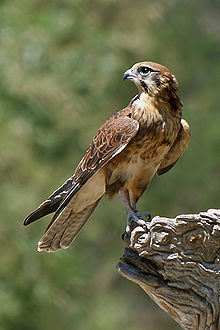Falcón
| Falcon Temporal range: Late Miocene to present |
|
|---|---|
 |
|
| Brown falcon (Falco berigora) | |
| Scientific classification | |
| Kingdom: | Animalia |
| Phylum: | Chordata |
| Class: | Aves |
| Order: | Falconiformes |
| Family: | Falconidae |
| Subfamily: | Falconinae |
| Genus: |
Falco Linnaeus, 1758 |
| Species | |
|
About 37; see text. |
|
| Synonyms | |
|
|
About 37; see text.
Falcons (/ˈfɒlkən, ˈfɔːl-, ˈfæl-/) are birds of prey in the genus Falco, which includes about 40 species. Falcons are widely distributed on all continents of the world except Antarctica.
Adult falcons have thin, tapered wings, which enable them to fly at high speed and change direction rapidly. Fledgling falcons, in their first year of flying, have longer flight feathers, which make their configuration more like that of a general-purpose bird such as a . This makes it easier to fly while learning the exceptional skills required to be effective hunters as adults.
The falcons are the largest genus in the Falconinae subfamily of Falconidae, which itself also includes another subfamily comprising caracaras and a few other species. All these birds kill with their beaks, using a "tooth" on the side of their beaks—unlike the hawks, eagles, and other birds of prey in the Accipitridae, which use their feet.
The largest falcon is the gyrfalcon at up to 65 cm in length. The smallest falcons are the kestrels, of which the Seychelles kestrel measures just 25 cm. As with hawks and owls, falcons exhibit sexual dimorphism, with the females typically larger than the males, thus allowing a wider range of prey species.
...
Wikipedia
